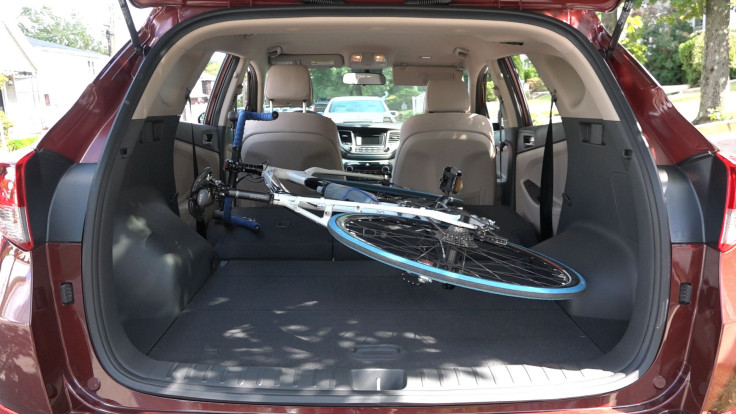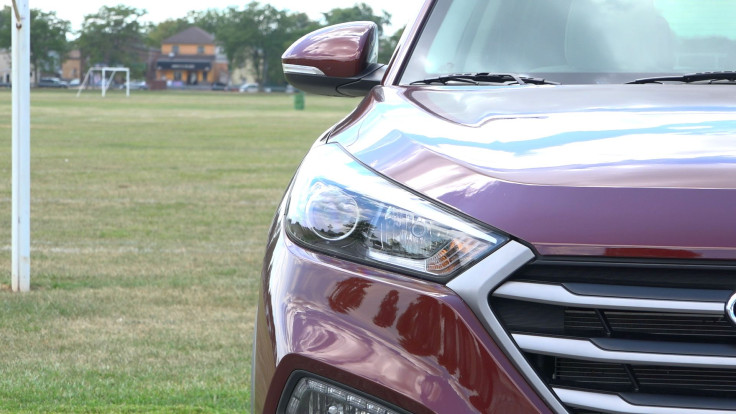2016 Hyundai Tucson Review: It's Boring, But That's A Good Thing [VIDEO]
The Hyundai Tucson is not exciting to look at, fun to drive or particularly cool. You’re not going to brag to your friends that you just bought one, nor are car enthusiasts in Mustangs and Subarus going to give you thumbs-up at red lights to validate your ticket to the cool car club. But a compact crossover’s job isn’t to be enthralling -- it’s to meet as many of your daily car needs as possible. At that level, the Hyundai Tucson succeeds: it’s quiet, comfortable and decently efficient, if a bit light on features.
Hyundai loaned International Business Times a Tucson Eco, equipped with its 1.6-liter, four-cylinder turbocharged engine attached to a new seven-speed dual-clutch transmission. In simple terms, they’ve stuffed a very tiny engine (the same size engine that powers the Fiesta ST hot hatchback , for example) in a heavy crossover in an effort to curb fuel consumption. While it certainly has its flaws, it’s probably the package that most prospective Tucson buyers will be considering. Still, depending on your priorities, this Tucson may not quite measure up to the competition.
Exterior
Let’s be honest, styling isn’t the main reason people buy cheap crossovers. Nothing in the segment is particularly daring, and the Tucson doesn’t challenge the status quo (though it does look better than the model it replaces). It’s going to blend into suburban parking lots everywhere, but the Ruby Wine paint our test car was sprayed with is a nice way to stand out a little bit.
Hyundai’s corporate horizontal grill dominates the Tucson’s face, supported by a pair of downturned headlamps. Past that, there’s not much to say -- the Tucson looks decent, but nobody’s going to bother you for photos at a gas station.
Interior

What I can say about the Tucson Eco’s interior is that it’s at least well-laid-out. The Eco lacks a large infotainment system, so many of the major functions are delegated to buttons, but it never felt overwhelming. The center console itself is tidy, though the standard 3.5-inch screen really isn’t useful for anything but displaying the time and radio station.
There’s a nice amount of storage space along the center stack and console, good enough for some big drinks, wallets, phones and whatever else you can think to fit in the cavernous armrest. Should you need them, each door also has its own built-in cupholder. The rear seats can fold nearly flat, revealing a vast cargo area; for reference, I fit my 58-inch frame road bicycle without having to remove the front wheel. There was still plenty of room to spare, so the Tucson will have no trouble carrying most of the things a typical crossover owner will throw in it. There is a downside to all of this utility engineering, however.
None of the materials used to make the Hyundai Tucson’s interior feel particularly nice. The things you touch most often -- the steering wheel, radio buttons, armrest -- those aren’t bad. But when you look around and start touching the dashboard and door panels, you notice the Tucson’s shortcomings. Granted, this is one of the cheapest versions of the car that you can buy, but it’s worth noting.
Features / Toys

Here’s where things get difficult for the Tucson. At the Eco trim level, you get a very basic car, with Bluetooth connectivity and some roof rails, for $25,000. The Honda CR-V EX is about $1,000 more, but it has lane departure warning, a 7-inch infotainment screen and a sunroof yet still gets 1 MPG more on the highway. The Mazda CX-5 Touring offers the same features as the CR-V except for the sunroof. So if you’re looking at the Tucson simply from a price/value perspective, keep in mind that the Eco model may not have some things you might expect at this price level. To get a blindspot monitoring system, you have to pay an extra $2,000 for the Sport trim, and to get a large touchscreen/infotainment panel, you have to spend $30,000 for the top-end Limited trim -- both of which lose 3 MPG on the highway, even before you tick the AWD option box.
Powertrain

Hyundai has heavily promoted the little 1.6-liter turbo engine and the 7-speed transmission, talking about accessible power, quick shifts and great MPG ratings. The motor does produce respectable numbers (175 HP and 195 TQ, respectively) and the dual-clutch transmission does shift up and down really nicely when you’re really hammering the throttle. When you’re cruising on the highway at 70 MPH, the Tucson is quietly humming away at just over 2,000 RPM, where I observed a slightly better-than-advertised 34 MPG thanks to the Eco tires.
The bad news is that the Tucson can’t defy physics. It’s still a heavy vehicle: 3,400 pounds at its lightest, 3,700 at its fattest, with a tiny engine and a lot of gears (Hyundai, please put this drivetrain in the Elantra GT!). This translates into a lack of cohesion and power in city environments, where the heft gives the computer reason to ask itself: “Do we need to downshift one gear or two?” to which it usually answers its own question with, “Ah, screw it, let’s go with three!” The turbo spins up, and all of a sudden you get a big burp of torque two seconds after you needed to get into the next lane. As you might imagine, this isn’t the smoothest experience.
Nor is it the most economical. Even with the lightest touch, I never could match Hyundai’s claimed 26 MPG city; the best I managed was 24. Once you get the car up to speed it’s fine, but leapfrogging city and suburban traffic without shifting the transmission yourself isn’t the smoothest experience. Over the week I had the car, I averaged 28 MPG with a 50/50 city/highway mix.
Handling

Look, the Tucson is a cheap crossover. It’s not meant to do anything exciting or put a smile on your face as you nail the apex of a corner. The brakes are mushy, and steering feels more like a suggestion than a command. Yet, even on the hard, low-rolling resistance tires, the Tucson actually deals with corners -- even long, higher speed sweepers that I push sports cars around -- pretty well. Sure, there’s tremendous body roll, but it’s well-controlled. It’s not entertaining, but for a vehicle of its heft and height, it’s better than expected.
Conclusion
If you’re determined to spend a maximum of $25,000 on a small/mid-size crossover as a family car, the Hyundai Tucson Eco does have a few things going for it. It’s quiet, safe, decent to look at and, transmission aside, very simple. Plus it comes with Hyundai’s famous lengthy warranty. This segment is incredibly competitive, though, and depending on what features you want, the Tuscon may not fit.
© Copyright IBTimes 2024. All rights reserved.





















